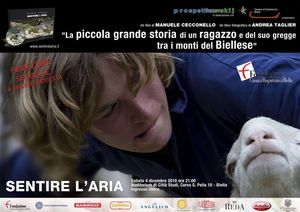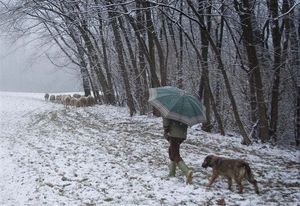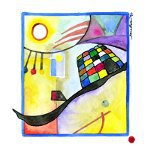«To feel the air» shepherds today

Il pomeriggio di Mercoledì 27 Ottobre scorso ha avuto luogo in Biella la presentazione del libro Sentire l’aria, catalogo delle edizioni Prospettiva Nevskij a corredo della mostra fotografica inaugurata lo stesso giorno presso lo Spazio Cultura della Fondazione Cassa di Risparmio di Biella, esposizione aperta fino al prossimo 19 Novembre. Venerdì 12 Novembre p.v., poi, a latere di tutto ciò, avrà luogo la proiezione, in anteprima nazionale, dell’omonimo film documentario presso le sale di Palazzo Ferrero di Biella. Un’iniziativa culturale complessa, a cura del fotografo Andrea Taglier e del documentarista Mauro Cecconello, realizzata, come bene hanno sottolineato l’avvocato Luigi Squillario, Presidente della Fondazione, ed il dott. Gianfranco De Martini, Presidente della Camera di Commercio di Biella, grazie al contributo di diversi sponsor e focalizzata nell’ambito del Progetto di valorizzazione delle lane autoctone del Piemonte, con il patrocinio degli enti territoriali locali. Un disegno editoriale originale in questi tempi di modernità nei quali gli antichi mestieri, come quelli agro-pastorali, sono spesso sulla cronaca delle testate giornalistiche a causa della crisi socio-economica, oggetto di marginalismo, pregiudizio, disinteresse e, talora, di qualche malcelata speculazione di varia natura.
Sentire l’aria, infatti, vede come protagonista la vita contemporanea dei bergé, i pastori nomadi di greggi che oggi operano all’ombra delle Alpi Biellesi. In particolare il fulcro del lavoro focalizza la sua attenzione sul percorso di crescita biennale di Andrea, un adolescente che a 16 anni ha deciso di non proseguire oltre il cammino esistenziale consueto dei suoi coetanei, per andare, invece, riecheggiando i modi dire del mondo contadino tradizionale, a «rubare il lavoro» ai vecchi sapienti per farlo proprio, come bene ha sottolineato, durante la presentazione, Piercarlo Grimaldi, Professore di Antropologia Culturale presso l’Università degli Studi di Scienze Gastronomiche di Pollenzo (CN). Attraverso la guida dell’anziano mentore Niculìn, vera e propria icona della locale figura pastorale, il giovane è cresciuto per due anni vivendo a stretto contatto con gli animali che ha portato a pascolare nelle quattro stagioni e con ogni situazione climatica, dalla neve al sole, dal caldo al freddo, in una natura spesso apparentemente silenziosa sebbene risuonante dei suoni e dei soffi di una vita che, per i più, apparirebbe oggi lontana, ancestrale e, per certi versi, oramai incomprensibile e, quasi “minacciosamente”, caratterizzata dall’elemento della solitudine. Tanto che, ad un certo punto, il giovane protagonista della narrazione per immagini sembra affermare un concetto fuori da ogni logica contemporanea e che così, all’incirca, risuona: «Io quissù mi sento in paradiso con le bestie, non so cosa pensino loro».
Ci si potrebbe quindi chiedere: chi è costui? Un soggetto “unico” o, si scusi il coinvolgimento della figura devozionale, un novello “san Francesco” che lascia tutto per un’altra vita? E come considerare l’insieme e l’oggetto di un simile progetto editoriale che coinvolge enti di rilievo economico e politico? Si tratta, in realtà, di rimodulare i punti di vista e di scansare stereotipi e pregiudizi che incrostano la nostra capacità di osservare e giudicare, giungendo a capire come una simile realtà, sebbene non maggioritaria, non sia “anormale”. Se bene si riflette, nell’ultimo lustro il grande pubblico ha accolto con grande entusiasmo tutte quelle iniziative che hanno visto realtà di ogni campo della Tradizione o “fuori dal quotidiano contemporaneo” essere portate alla ribalta. Si tratta di uno “schema” che, ad esempio, nel mondo del cinema, ha visto il successo di film aventi a tema anche la vita monastica, come il Il Grande Silenzio – Die Große Stille (Germania 2005) di Philip Gröning, girato nel Monastero della “Grande Chartreuse” sulle Alpi Francesi, ed oggi Uomini di Dio del regista Xavier Beauvois, sui monaci di Tibhirine (Algeria), ove si evidenzia un modello di vita «umanissima, fatta di gesti quotidiani, di limiti e di paure, di ritmi e vicende addirittura quasi banali, di non apparizione, di quotidianità ripetitiva … una scelta operata da persone normalissime, magari profondamente diverse tra loro per cultura, formazione, sensibilità, ceto sociale … nel suo voler cercare il senso di ciò che si vive, nell’anelare a tradurre in scelte quotidiane nella loro ordinarietà le convinzioni più profonde che lo animano, nel non lasciarsi condizionare dai comportamenti della maggioranza», così richiamando nello spettatore «desideri sopiti, aneliti a una vita più umana e pacata» ((cfr. E.Bianchi, Il fascino quotidiano del bene, in La Stampa, 24 Ottobre 2010)).
In effetti, attraverso le fotografie e le sequenze del film, l’osservatore di Sentire l’aria potrebbe venire introdotto in un mondo che riporta alla memoria, ai più, il palinsesto televisivo di una volta, prima che la pubblicità prendesse il sopravvento, ossia le immagini dell’Intervallo accompagnate dal sottofondo di musica per xilofono. Una visione per la quale in passato qualcuno ha scritto, quasi paradossalmente, che «le pecore non sono un avvenimento, sono una pausa», senza considerare che, in realtà, oltre le apparenze, «non si tratta di un modello di vita alternativo o contrapposto al modello dominante della cultura contemporanea», in quanto potenzialmente «capace di inserirsi nel contesto attuale proponendo un rapporto positivo tra locale e globale» purché continuino ad esistere i pastori quali custodi delle radici, del territorio e dei cosiddetti prodotti di qualità dell’identità. In quanto «i pastori chiedono di essere messi in condizione di lavorare, di essere aiutati a creare un serio sistema di commercializzazione del loro prodotto, di essere inseriti in un sistema di informazione e sensibilizzazione sulle realtà e i valori del territorio di appartenenza, sostenuti nelle attività di cura e manutenzione del territorio in cui lavorano» ((cfr. A.Sulis e S.De Paulis, Pastori&Pastori. Ci uniscono le pecore, ci divide il mare, articolo on-line sulla rivista Slowfood; C.Fanti, Pecore d’Italia, pezzo on-line sulla rivista Slow)).
Ecco, quindi, che a Biella, come già segnalato in occasione della Festa del Vino 2010 di Gattinara (VC) del Settembre scorso ((cfr. Il Messaggero Sardo, Ottobre 2010, p. 24; Tottus in pari n. 308, Settembre 2010, p. 3)), le istituzioni locali e gli operatori del settore stanno cercando di muoversi lungo questo solco per “fare sistema” a tutto tondo, utilizzando anche la proposta culturale. Perché un domani, come ha segnalato il professor Piercarlo Grimaldi, durante la conferenza di presentazione di Sentire l’aria, non risuonino le amare considerazioni dello scrittore portoghese José Saramago, premio Nobel per la letteratura, quando, osservando prima di morire i campi che circondano oggi il suo paese nativo, coperti da piante di granoturco dai chicchi sempre uguali, ove, in passato, esistevano ulivi antichi e nodosi, ci si venga a chiedere metaforicamente «non so davvero dove andranno a rifugiarsi le lucertole?» ((cfr. J.Saramago, Le piccole memorie, Einaudi, Torino 2007, pp. 3 e ss.)).
Gianni Cilloco
«To feel the air» shepherds today

In the afternoon of the 27 October 2010 toke place in Biella the launch of the book “Sentire l’aria” “To feel the air” a catalogue published by Prospettiva Nevskij as accompaniment to the photographic exhibition launched on the same day. The exhibition is open until the 19 November at the venue Spazio Cultura of the Foundation Cassa di Risparmio, Biella.
Following those events the 12 November will be premiered a documentary with the same title in the hall of Palazzo Ferrero, Biella. This complex cultural operation is curated by the photographer Andrea Taglier and by the documentary maker Mauro Cecconello.
As the avv. Luigi Squillario, President of the Foundation, and dott. Gianfranco De Martini, President of the Chamber of Commerce of Biella, have rightly pointed out, this operation has been possible thanks to the contributions of a number of sponsors, focalized within the scope of the Project of revaluing the native wools of Piedmont and with the support of the local government boards.
To feel the air is a publishing initiative with a different message for our current modern times where the old traditional trades, as the agro-pastoral ones, are to be found in the heading of newspapers only in the context of the socio-economic crisis and as object of marginalization, prejudice and lack of interest.
The protagonist of To feel the air is the life of the berge’, the nomadic shepherds of herds that are operating today in the shade of the biellese Alps. More specifically the attention of the work is on the growth journey of Andrea, a teenager that at the age of 16 decides to stop following the usual path of his age group. Instead he decides to go and “steal the job” (to use an expression from the traditional rural world) from the knowledgeable old guys to make it his own. This aspect was highlighted in the presentation by Piercarlo Grimaldi, Professor of Cultural Anthropology at the University of Studies of Gastronomic Science of Pollenzo (CN).
Under the guide of the elderly mentor Niculìn, iconic figure of the pastoral world, Andrea spend two years living in close contact with the animals that he take to pastures through four seasons and under any weather conditions. From snow to sun, from hot to cold, in a natural environment apparently silent except from the sounds of a life that it would appears to most people ancestral, remote, incomprehensible and almost “menacingly” characterized by solitude.
So much that at a certain point the young protagonist of this narration by images says something that seems outside any contemporary logic: “Up here, I feel in paradise with the animals. I don’t know how they feel about it”.
You could ask yourself: who is this guy? Is he a unique person or a new San Francis that leaves everything for a different life?
And how to consider the overall and the subject of such publishing project that involves prominent economical and political bodies?
In effect it is a matter of readjusting points of view and of moving aside stereotypes and prejudices that encrust our ability to observe and evaluate; in order to arrive to understand how this reality is not “abnormal”.
In considering the last 5 years, the general public has received with big enthusiasm all the initiatives presenting realities from every field of Tradition and “outside contemporary everyday life”. For instance in the cinematic world, this tendency has deliver very successful movies about monastic life as Die Große Stille (Germany 2005), directed by Philip Gröning and shoot in the Big Chartreuse monastery in French Alps and more recently Men of God directed by Xavier Beauvois, about the monks of Tibhirine (Algeria).
Those movies are pointing out a model of life” very human, made of daily gestures, of limits and fears, of rhythms and events almost banal, of repeated daily patterns… choices made by normal people, from a variety of different cultural background, social class, education and sensibility, seeking to give a meaning to their life, translating their profound convictions into humble daily activities, refusing to be conditioned by the behavior of the majority”. And those movies are activating in the viewers” sleepy desires, yearnings for a life more humane and calm” ((E. Bianchi The fascination of everyday goodness. article published in La Stampa, 24 October 2010)).
Through the photographs and the sequences in the movie the viewer of ““To feel the air” can be transported in a world that belong to the memory. Some people will be taken back to those times before advertising toke over television, to the peaceful images of Intervallo with the xylophone music as a background. A vision that once generated the comment that” sheep are not an event, are a pause”. In effect this “is not a model of alternative life or opposing the dominant model of contemporary culture”; but instead is a reality potentially able to coexist with the current context and proposing a positive relationship between the global and the local, as long as the shepherds continue to exist as the custodians of the roots, of the land and of the products qualifying the identity.
The shepherds are asking to have conditions allowing them to work, to be helped in creating a valid system to commercialize their products, to be included in a system of information about the reality and values of the territory their belong to, to be supported in the activities of maintenance and care of the territory where they work. ((A. Sulis e S. De Paulis, Shepherds&Shepherds. The sheep are uniting us, the sea is dividing us. On-line article on the Slowfood magazine; C. Fanti, Sheep of Italy, on-line on the magazine Slow)).
Also in Biella, as was mentioned in September during the Vine Festival 2010 in Gattinara (The Sardinian Herald, October 2010, page 24) the local institutions and the sector’s operators are trying to progress in this direction of creating a round system, utilizing also the cultural proposition.
In a way that the future will not resonates with bitter considerations. Professor Piercarlo Grimaldi in his presentation to “To feel the air”, did remind us of the metaphor of the Portuguese writer José Saramago, Nobel prize for literature, who before dying was looking at the fields surrounding his native village all covered of identical corn plants, instead of the ancient knotty olive trees that used to existing on that land. “I really don’t know where the little lizards will find shelter” (J. Saranago. The small memories. Einaudi publisher, Turin 2007, page 3).
by Gianni Cilloco tradotto da Chiara Corbelletto, Auckland
